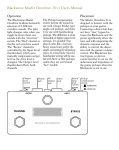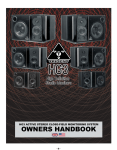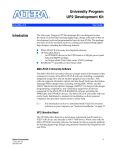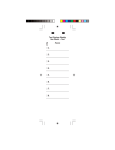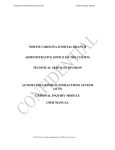Download Operation Placement Blackstone Mosfet Overdrive 2Sv2 User`s
Transcript
Blackstone Mosfet Overdrive 2Sv2 User’s Manual Operation Placement The Blackstone Mosfet Overdrive allows selection of two overdrive presets. The pilot light changes color when you toggle between these two sounds with the “CHANNEL” footswitch. The two presets are referred to as the “Brown Channel” and the “Red Channel”. The two channels are the same, except that the Red channel has a feature that’s useful for high-gain sounds. The RED DRIVE control is split in half. Minimum is at 12:00. When you crank it all the way to the left, there’s a bass cut which keeps humbuckers or P90s snappy and sassy. The drive and output level of each channel are adjustable with the slotted potentiometer controls in the top of the unit. These can be turned with your thumbnail, or a guitar pick. The “POST EQ” control effectsboth channels. Fully clockwise is the flat setting. Rotating counter-clockwise decreases mids and highs to affect a bass boost. Rotating to the left of the mid-point adds back highs while leaving the midrange cut. The Mosfet Overdrive 2s is designed to interact with the pickups on your guitar. Connecting a device that does not have “true” bypass between the Blackstone and the guitar significantly alters the tone, and will compromise the dynamic response and the ability to control the distortion with the guitar’s volume control. Wah-wahs with true or “single-pole” bypass can usually be placed ahead of the Blackstone, but may not perform properly if the Blackstone’s Drive is at or near maximum. The Blackstone has true mechanical bypass. Internal adjustments The pedal comes adjusted to the recommended internal settings. The following is just for electronics geeks and obsessive types. There are two trimmer potentiometers accessible inside the unit that can be reset to further personalize the sound. A jeweler’s screwdriver will be needed. Care should be taken to avoid torquing the pots past their stops. The overall drive level, for both channels, may be adjusted with the trimmer marked “GN 2”. This adjusts level at a different point in the circuit than do the external drive controls. If you like the Blackstone’s tendency to get more midrangey at maximum settings, but want more or less distortion at that extreme, you may want to adjust the GN 2 trimmer. Turning it up all the way may cause instability and oscillations. The “TRBL” trimmer adjusts treble early in the circuit. It works in conjunction with the GN 2 trimmer, such that it has more effect the lower GN 2 is set. The Presence Limiting Capacitor is a socketmounted user-replaceable capacitor that controls how much very high frequency signal the final gain stage will pass. 330pF is standard. Replacing it with a smaller value (such as 220pF or 100pF) will increase presence. A higher value (such as 470pF) will attenuate presence. Ceramic caps, such as those found at Radio Shack, are fine. The leads on the cap must be .025" (.6mm) or less in diameter. Power Adaptor Post EQ Behavior The Mosfet Overdrive may be powered by a 9VDC adaptor. The connector must be a 2.1 x 5.5mm plug, with the center negative. Most supplies intended to power guitar pedals work well, but cheap unregulated adaptors may impose a hum. Under critical studio conditions, battery power insures hum-free operation. Current consumption is approximately 21mA. Do not run the Mosfet Overdrive with a power supply of more than 10 volts. Battery An alkaline battery will provide about 24 hours of operation. Unplugging the input connector turns off the battery; the bypass switch does not. These curves illustrate the effect of the post-distortion EQ only, not the frequency response of the entire system. blackstoneappliances.com




